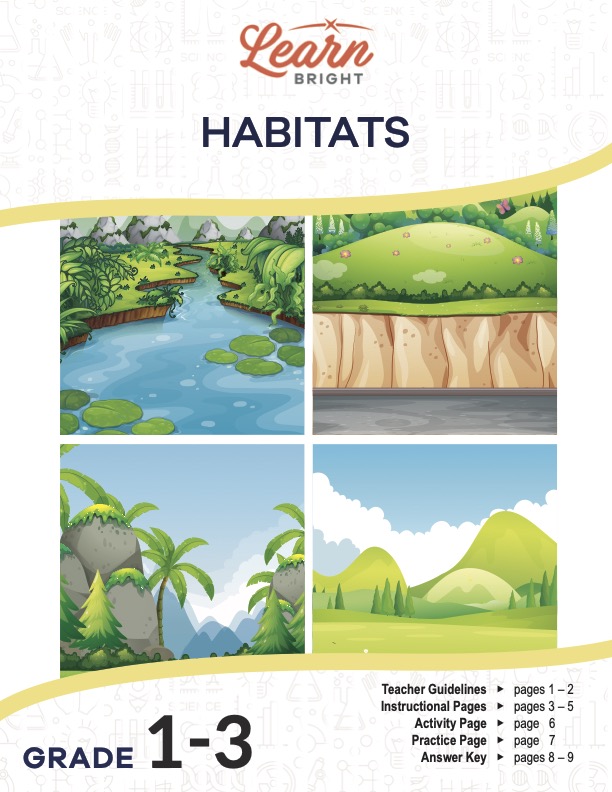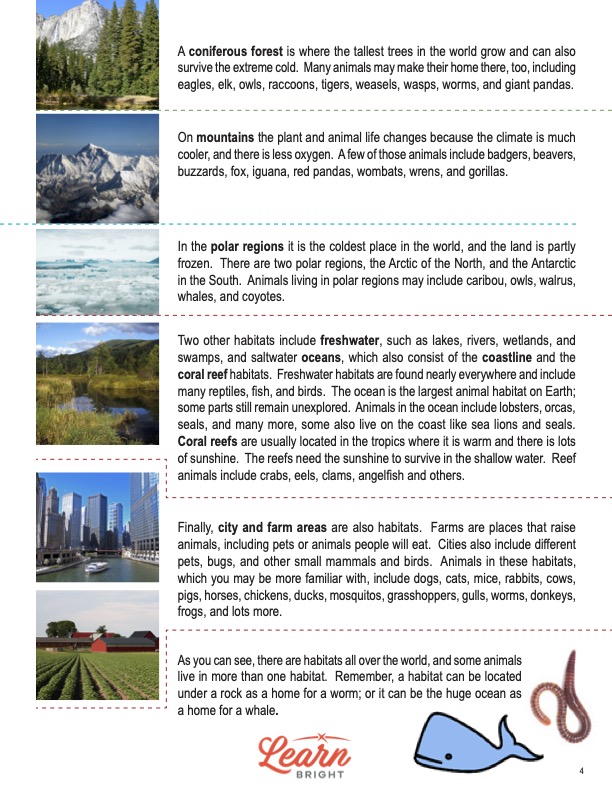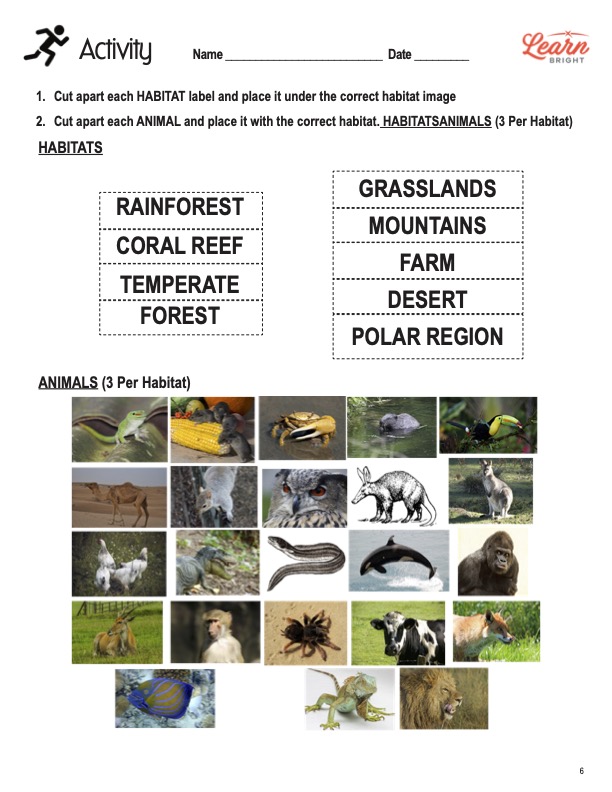Description
What our Habitats lesson plan includes
Lesson Objectives and Overview: Habitats teaches students about the many pieces that make up a specific kind of environment. Students will discover how many different kinds of habitats there are. They will be able to provide examples and identify some of the animals that call these different settings home. This lesson is for students in 1st grade, 2nd grade, and 3rd grade.
Classroom Procedure
Every lesson plan provides you with a classroom procedure page that outlines a step-by-step guide to follow. You do not have to follow the guide exactly. The guide helps you organize the lesson and details when to hand out worksheets. It also lists information in the yellow box that you might find useful. You will find the lesson objectives, state standards, and number of class sessions the lesson should take to complete in this area. In addition, it describes the supplies you will need as well as what and how you need to prepare beforehand. In addition to the handouts, this lesson requires you to supply scissors, glue or paste, and paper.
Options for Lesson
You will find several suggestions in the “Options for Lesson” section of the classroom procedure page for additional activities or alternative ways to go about aspects of the lesson plan. A few suggestions relate to the activity worksheet. One option is to add more images to the collection on the worksheet. You could allow students to work in pairs rather than alone to complete the activity. If you teach lower grade levels, you could choose to do the activity together as a whole class. Another suggestion is to allow students to access the internet to watch videos regarding various habitats or to research more about them and the animals that live in them. A final suggestion is to use the practice page as a homework assignment instead of as an in-class worksheet.
Teacher Notes
The paragraph on this page provides a little extra information or guidance on the lesson plan. It suggests maybe teaching students about each of the habitats individually and making them their own lessons. It also mentions that you can easily adjust this lesson for higher grade levels if you need to. Use the blank lines on this page to write down any other ideas or thoughts you have prior to giving the lesson.
HABITATS LESSON PLAN CONTENT PAGES
Introduction to Habitats
The Habitats lesson plan contains two pages of content. The first page explains to students what a habitat is and what it includes. Depending on where they live, students might live in a habitat where the temperature changes often or one where it stays relatively the same. There may be lots of trees or only a few. No matter where they live, that place is their habitat.
The lesson define habitat as the environment where a living organism (such as people) exists, and it includes plants, animals, and even non-living things. Some habitats are large while others are fairly small. An entire continent could share a single habitat. At the same time, one might exist under a rock.
There are many types of habitats throughout the world. This lesson describes ten specific habitats and provides a few facts about each one. As the teacher notes page mentions, you may choose to devote entire lessons to one or two habitats at a time.
Grassland, Desert, and Rainforest
The first habitat students will learn about is grassland. A grassland area is full of tall grasses and does not have very many trees. Every continent except for Antarctica has grassland regions. There are multiple kinds of grasslands, such as prairies and savannas. Prairies don’t need as much rainfall as savannas do. Animals that live in these places include antelopes, brown bears, lions, hippos, and turkeys.
Deserts are extremely dry regions that get lots of sunlight and receive very little rain, fewer than six inches a year. There are not a lot of plants in these areas. Many people may not realize that not all deserts are hot. Some can be very cold, sometimes reaching temperatures below freezing at nighttime. There are deserts everywhere. Some of the animals that live in this kind of habitat are snakes, birds, camels, tarantulas, and kangaroos.
Students will then learn about rainforests. Unlike deserts, rainforests receive rain constantly all year long. By comparison, a seasonal forest has a rainy season and a dry season. Both, however, receive more than eight feet of rain a year. There are more animals living in rainforests than there are in all the other habitats combined. Rainforest animals include baboons, butterflies, frogs, monkeys, newts, elephants, and crocodiles.
Temperate Forest, Coniferous Forest, Mountains, and Polar Regions
A temperate forest contains many trees. Sometimes the trees have leaves that change colors and fall off in the winter. Others remain green all year long. The United States has many temperate rainforests. Most continents have these regions. The climates of temperate forests range from cold to hot. Some of the animals that live here are eagles, raccoons, tigers, worms, and giant pandas.
Another kind of forest, and habitat, is the coniferous forest. This kind of forest is where people find the tallest trees in the world. This is because these trees can survive the extreme cold. Animals that call these forests home include badgers, foxes, red pandas, wrens, and gorillas.
The polar regions are the coldest places in the world. The land is actually partly frozen. The two polar regions on Earth are the Arctic in the North and the Antarctic in the South. Some of the polar animals are caribou, owls, whales, and coyotes.
Coral Reef, City, and Farm
Students will next learn about coral reefs. First, the lesson describes freshwater and ocean habitats. Lakes, rivers, wetlands, and swamps are all freshwater areas, which are nearly everywhere. The ocean is the largest habitat in the world, and people still haven’t explored all of it yet. The ocean is also home to smaller habitats like coastlines and coral reefs. Coral reefs are usually in tropical areas where the temperature is warm and the sun shines a lot. These reefs need the sun’s light to survive in the shallow water. Some of the animals that live in coral reefs are crabs, eels, and clams.
City and farm areas are also their own habitats. Farms raise animals, including pets or the animals people will eat. Cities include different pets, bugs, and other small mammals and birds. Students will likely be very familiar with some of the animals in these habitats. The animals include dogs, cats, rabbits, cows, pigs, horses, ducks, grasshoppers, worms, and many more.
HABITATS LESSON PLAN WORKSHEETS
The Habitats lesson plan includes two worksheets: an activity worksheet and a practice worksheet. These handouts help reinforce students’ comprehension of lesson material. The guidelines on the classroom procedure page outline when to hand out each worksheet to the class.
MATCH THE ANIMAL ACTIVITY WORKSHEET
For the activity, students will cut out the nine labels on the worksheet and place them under the images of each habitat. Next, they will cut out the animals and place them with the picture that matches where they live. There are three animals for each environment and eight total environments. As the options on the classroom procedure page suggest, you may choose to have students work with a partner or in small groups for this activity rather than on their own.
HABITATS PRACTICE WORKSHEET
There are two sections on the practice worksheet. For the first part, students must read 12 descriptions and match them to the correct term from the word bank. There are only 12 terms, so they will use each word only once. The second part requires students to fill in the blanks in a short paragraph. Students will need to use what they learned in the lesson as there is not word bank to reference.
Worksheet Answer Keys
The last two pages of the lesson plan document are answer keys for the two worksheets. The activity answer key provides lists of the animals that belong in each habitat. For the practice answer key, the correct responses are in red. Because the second section of the practice worksheet does not include a word bank, the answer key provides the right responses that students should also have. If you choose to administer the lesson pages to your students via PDF, you will need to save a new file that omits these pages. Otherwise, you can simply print out the applicable pages and keep these as reference for yourself when grading assignments.










